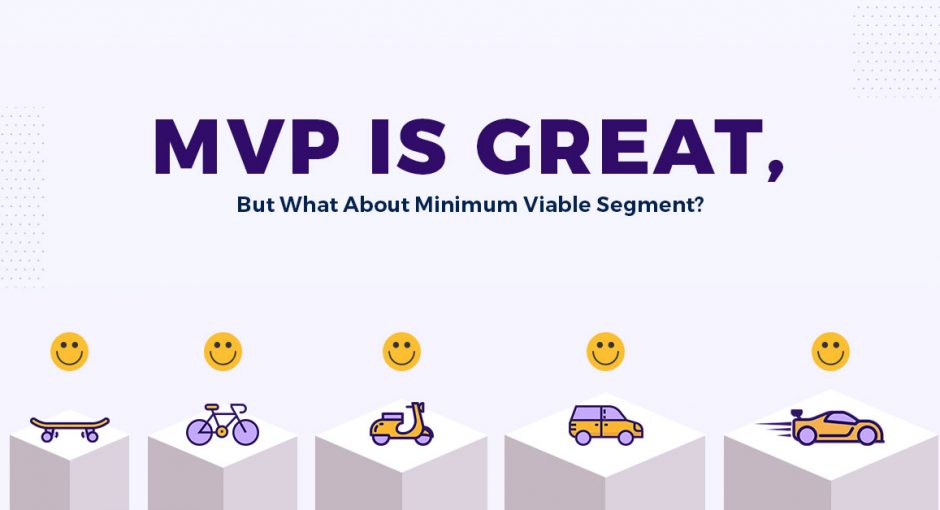To ideate and build a product that can penetrate a billion-dollar market and enthuse millions of customers is a glorious feeling for any entrepreneur, and a great goal indeed. For such goals, your minimum viable product (MVP) and the selection of your minimum viable segment (MVS) should be fundamentally sound.
So what are those steps
Building a Minimum Viable Product (MVP) is certainly one of them. It’s a smart way to validate your business model, by launching a version of the product having minimum features, without compromising on its viability.
But to make your MVP even more effective, shouldn’t there be a Minimum Viable Segment (MVS), say, an initial customer base? It can further streamline your development process and get you more traction in the initial days.
Where do Startups go wrong?
Startups at times are unable to look beyond their MVP, maybe because they focus more on the product, which is why their search for a ‘Product-Market Fit’ doesn’t end.
They go hammer and tongs to dominate the market. They paint the market with broader strokes and fail to identify their Minimum Viable Segment. Many would argue that it’s a natural progression to not look for a specific market segment when launching a product and target customers aggressively instead. This is how you can serve a multitude of market segments and customers’ expectations. Right?
This may seem to be enterprising in the beginning, but gradually it starts pulling the development team in different directions, leading to much chaos.
The hardest part is to decide what not to do or which feature not to implement. – Steve Jobs
It applies to customers and market segments as well. If you think about it, every product is built keeping certain customer personas in mind. These personas should serve as the template for your Minimum Viable Segment. Though you mustn’t confuse this segment with early adopters. You can learn more about customer personas here.
It comprises of customers who are most likely to buy your product, for the price you set and in the way you imagined/designed. It’s a fragment of your target market, small enough to get covered quickly and yet generate decent revenue to make the business model sustainable.
Pandering to MVS is like playing the game of darts from close quarters — the chances of hitting the bullseye become more realistic.
So how big should that initial segment be? Well, it’s a million-dollar question. If we take a SaaS product into consideration, 1000 customers is a decent number to start with. For instance, if a product is targeting restaurants, then the minimum viable segment can be 1000 Italian restaurants in a particular region. This can give you an insight into customers who have similar tastes and expectations, therefore propelling your competitive advantage.
It’s about pandering to the similar needs and pain points
To simply put it, in an ideal MVS, a set of customers will share similar needs and pain points. So the idea is to trace such customers and gradually build a small segment for your MVP.
Your product is not the features you build, but the ‘Needs’ it caters too. It’s an important realization, as customers don’t think in terms of features, but in terms of pain points.
When there is a pool of consumers who are looking for similar solutions, referencing one another becomes a lot easier. People are able to build a healthy community where self-learning is encouraged. Such a community can save you a lot of time and money, as you won’t need to stretch your support team, at least during the initial days of your product.
Now just imagine a pool of consumers who are facing different issues with the product and you are providing solutions accordingly. Do you think people will be able to reference one another that easily?
Don’t confuse MVS with Vertical Market
Choosing a Vertical, say Financial Services as your initial segment isn’t the smartest thing to do, as it’s too broad. It’s important to break down that vertical further, say into Banking, Brokerage, Insurance, etc., to discover a set of potential customers having the same requirements.
MVS requires iterations, just like MVP
You should remain in the ‘Calibration Mode’ while figuring out your MVS. If you have zeroed in on a segment, do you think all customers in that segment have the same requirements? You need to keep iterating until you get the answer. Interviewing customers will help you with this. So the bottom line is, you need to keep refining your MVS.
There is more to it
Some factors which you may overlook while zeroing in your MVS:
- How well-connected are the customers who make-up your MVS?
- Do they connect on community forums? The more they interact on such forums, the more they will refer to one another, making things go viral for you.
- Can all your targeted customers be reached via the same channels? If yes, then it’s great news for your marketing endeavors.
Don’t forget the adjacent segments
You can’t afford to be myopic and take a back seat after discovering your MVS. It’s better to keep an eye on the adjacent segments having similar customers with similar tastes and expectations. The ideal way is to seamlessly shift from one segment to the other, broadening your market in return.
There is no rocket science in figuring out MVS. Once you become a part of the process, you understand how obvious it is. That said, there are entrepreneurs who miss this obviousness. They condition themselves to find flaws only in the product and not in the way they are targeting customers. So MVP is great, but you need to bring MVS into perspective as well. This is how the right product issues can be highlighted and addressed. Issues that concern the genuine needs of your customers.
MVP and MVS are dancing partners. Once you imbibe this gospel, you will build something state-of-the-art and profitable.






